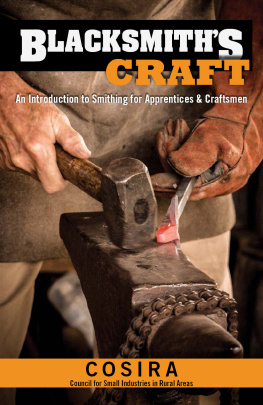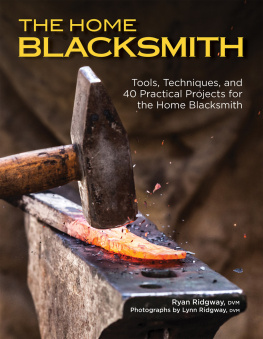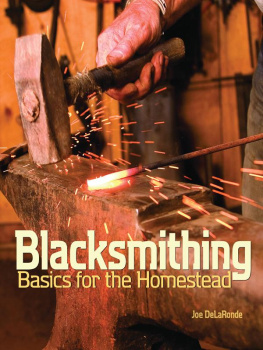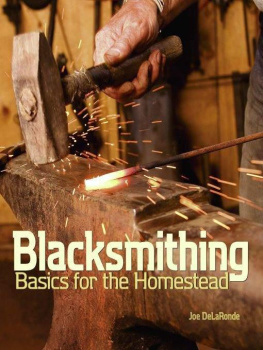Contents
Guide


THE BLACKSMITHS CRAFT

Dear Reader:
Were very happy to bring the classic Blacksamithing Series from COSIRA (Council for Small Industries in Rural Areas) back into print. In the 35 years I have worked as a bookseller and publisher, certain iconic titles stick out. This series is one of those considered a classic because the photographs, text, and illustrations are so complete and highly focused on its subject.
The series:
Blacksmiths (978-1-4971-0046-6)
Wrought Ironwork (978-1-4971-0064-0)
Decorative Ironwork (978-1-4971-0063-3)
You hold the Blacksmiths Craft volume in your hand. As you read, please be aware that we have not made any attempt to update the techniques or tools. Consider this treasure trove of knowledge a time capsule from the past.
May you be inspired to pick up the blacksmiths hammer and try your hand at this ancient skill.
Enjoy!
Alan Giagnocavo, Publisher
Fox Chapel Publishing
1952 by Rural Development Commission. This edition copyright 2019 by Fox Chapel Publishing.
All rights reserved. Blacksmiths Craft was originally published by Rural Development Commission under the title The Blacksmiths Craft in Great Britain. This version published by Fox Chapel Publishing Company, Inc, 903 Square Street, Mount Joy, PA 17552.
The patterns contained herein are copyrighted by the author. Readers may make copies of these patterns for personal use. The patterns themselves, however, are not to be duplicated for resale or distribution under any circumstances. Any such copying is a violation of copyright law.
Print ISBN 978-1-4971-0046-6
eISBN 9781607657286
The Cataloging-in-Publication Data is on file with the Library of Congress
To learn more about the other great books from Fox Chapel Publishing, or to find a retailer near you, call toll-free 800-457-9112
or visit us at www.FoxChapelPublishing.com.
We are always looking for talented authors. To submit an idea, please send a brief inquiry to
.
Contents
CHAPTER
Lesson
Lesson
Lesson
Illustrations
PART I
FIGURE
PART II
PART III
Note.The line drawings and half-tone illustrations in the Lessons in Parts II, III and IV are not included in this list.
PREFACE
This book has been published by the Council for Small Industries in Rural Areas because there appeared to be no text book on blacksmithing today which could meet the needs of craftsmen, technical schools and apprentices training centres. The lack of such a book was a handicap to the teaching of this subject and particularly to young men who are receiving instruction from the Council in country workshops. Although written primarily for these men, it will also be of great value to many other craftsmen and apprentices whose work depends on a sound knowledge of the behaviour of iron and steel.
The skill of the smith has been faithfully recorded in sequences of still photographs married to brief descriptive captions. The sequences are arranged in lessons which should not be difficult to follow if text, drawings and photographs are carefully studied. The Council realizes that some of the methods shown and described are not the only ones possible. In such cases the variations have been carefully considered, and the methods chosen have been those which seemed best for the beginner: as he gains experience, the smith can develop his own variations of a technique.
The Smith also sitting by the anvil,
And considering the iron work,
The vapour of the fire wasteth his flesh,
And he fighteth with the heat of the furnace;
The noise of the hammer and the anvil is ever in his ears,
And his eyes look still upon the pattern of the thing that he maketh;
He setteth his mind to finish his work,
And watcheth to polish it perfectly:
Ecclesiasticus
INTRODUCTION
FORGING is the oldest method of making things from iron and steel. It remains an essential craft, because farmers still need within easy reach of their farms workshops where they can be sure of an efficient and prompt repair service. To give such a service today, the skill of a blacksmith must be combined with the techniques of gas or arc welding and flame cutting, but the craftsman who possesses only the techniques of a welder without a knowledge of forging will be seriously handicapped. His lack of smithing skill will oblige him to use welding and flame cutting for jobs which could be done cheaper and better by forging.
An example is the fitting illustrated in by rolling a piece of plate round a mandrel and then welding the seam, thus saving time and material.
Metal forged at the correct heat loses none of its strength but if, for instance, a piece of metal is merely heated by a blow pipe flame and pulled or hammered over a vice, its structure is weakened and may give under strain. A blacksmith working hot metal on the anvil comes to understand his material better than he could in any other way. This is especially true of the smith who turns to ornamental ironwork in his spare moments, for this, besides being to many smiths an absorbing creative art and relief from their heavy work, is an excellent way of discovering the characteristic behaviour of iron. For these reasons, a blacksmith who also has a knowledge of welding techniques can give the farmer a much more versatile and useful service than the man who cannot forge his metal.

Fig. 1
The basis of the blacksmiths craft is set out in the pages which follow. There are four parts. describes the smiths simple equipment and his tools, his fuel and his fire, the processes he uses in his work and his raw materials. Parts II, III and IV open with a description of a particular technique which is essential to the lessons which are set out step by step in each part. Each of the photographs by which a technique is illustrated shows some detail of particular technical significance such as the position of the body, the correct grip of the tool in the hand, the angle at which the work is held. At the head of each lesson is a line drawing of the piece to be made, so that the progressive stages of the exercise will be more readily understood, and the relation of drawings to solid objects will become familiar.
A smith who has mastered these thirty-seven lessons will know the essentials of his craft.
PART I
CHAPTER 1
THE BLACKSMITHS EQUIPMENT
Forge equipment consists of the Hearth, the Blast, the Anvil and the Bench and Vice.

Fig. 2













